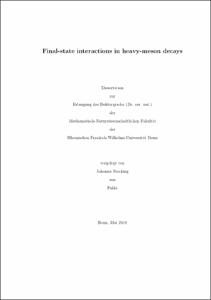Niecknig, Johanna: Final-state interactions in heavy-meson decays. - Bonn, 2018. - Dissertation, Rheinische Friedrich-Wilhelms-Universität Bonn.
Online-Ausgabe in bonndoc: https://nbn-resolving.org/urn:nbn:de:hbz:5n-51679
Online-Ausgabe in bonndoc: https://nbn-resolving.org/urn:nbn:de:hbz:5n-51679
@phdthesis{handle:20.500.11811/7619,
urn: https://nbn-resolving.org/urn:nbn:de:hbz:5n-51679,
author = {{Johanna Niecknig}},
title = {Final-state interactions in heavy-meson decays},
school = {Rheinische Friedrich-Wilhelms-Universität Bonn},
year = 2018,
month = aug,
note = {In the last decade the investigation of the heavy-meson sector has gained in importance, in particular for precision tests of the Standard Model and exploration of the physics beyond, such as CP violation. Experimentally, with the launch of the Large Hadron Collider (among several other experiments) great promise for high-precision analyses has been shown. At the same time a precise understanding and rigorous treatment of the theoretical aspects of the interactions is mandatory. In particular the strong final-state interactions, described by Quantum Chromodynamics, pose a challenge: at low energies, where the hadrons are the interacting degrees of freedom, the strong coupling becomes large and the standard perturbative solution methods fail. One non-perturbative approach is to apply dispersion relations, providing a model-independent framework that fulfills unitarity and analyticity constraints by construction. In this thesis we employ such dispersive techniques that allow one to either deduce the universal final-state interactions of light meson pairs from the accurately known ππ, πK, and KK phase shifts, or likewise deduce crucial information on meson-meson scattering from the respective final-state interactions. The thesis is subdivided into two projects.
The first project is concerned with the decays Bd,s → J/ψ(ππ,πη,KK), where the J/ψ is treated as an spectator and the pairwise final-state interactions of the light mesons are well described by the scalar and the vector form factors. In the scalar sector a coupled-channel treatment between the ππ and KK systems in the isoscalar sector and the πη and KK systems in the isovector one is required. The Bd,s → J/ψππ channels are studied as to demonstrate the benefits of our formalism. We find very good agreement with the data up to 1.05 GeV in the ππ invariant mass, with a number of parameters reduced significantly compared to a phenomenological analysis. In addition, the phases of the amplitudes are correct by construction, a crucial feature for many CP violation measurements in heavy-meson decays. By means of certain symmetry and coupled-channel relations we give predictions for the other channels, providing information on πη scattering. In the second project an analysis of the semileptonic D→πKlν decay is presented. A deliberate and accurate treatment of the hadronic final-state interaction can deliver information on pion-kaon scattering. The analysis is based on a modified Omnès formalism where left-hand-cut structures are approximated by pole terms derived in Heavy-Meson Chiral Perturbation Theory. For a precision determination of the amplitudes as it is required for an extraction of πK phases further constraints, both experimental and theoretical, are highly desired.},
url = {https://hdl.handle.net/20.500.11811/7619}
}
urn: https://nbn-resolving.org/urn:nbn:de:hbz:5n-51679,
author = {{Johanna Niecknig}},
title = {Final-state interactions in heavy-meson decays},
school = {Rheinische Friedrich-Wilhelms-Universität Bonn},
year = 2018,
month = aug,
note = {In the last decade the investigation of the heavy-meson sector has gained in importance, in particular for precision tests of the Standard Model and exploration of the physics beyond, such as CP violation. Experimentally, with the launch of the Large Hadron Collider (among several other experiments) great promise for high-precision analyses has been shown. At the same time a precise understanding and rigorous treatment of the theoretical aspects of the interactions is mandatory. In particular the strong final-state interactions, described by Quantum Chromodynamics, pose a challenge: at low energies, where the hadrons are the interacting degrees of freedom, the strong coupling becomes large and the standard perturbative solution methods fail. One non-perturbative approach is to apply dispersion relations, providing a model-independent framework that fulfills unitarity and analyticity constraints by construction. In this thesis we employ such dispersive techniques that allow one to either deduce the universal final-state interactions of light meson pairs from the accurately known ππ, πK, and KK phase shifts, or likewise deduce crucial information on meson-meson scattering from the respective final-state interactions. The thesis is subdivided into two projects.
The first project is concerned with the decays Bd,s → J/ψ(ππ,πη,KK), where the J/ψ is treated as an spectator and the pairwise final-state interactions of the light mesons are well described by the scalar and the vector form factors. In the scalar sector a coupled-channel treatment between the ππ and KK systems in the isoscalar sector and the πη and KK systems in the isovector one is required. The Bd,s → J/ψππ channels are studied as to demonstrate the benefits of our formalism. We find very good agreement with the data up to 1.05 GeV in the ππ invariant mass, with a number of parameters reduced significantly compared to a phenomenological analysis. In addition, the phases of the amplitudes are correct by construction, a crucial feature for many CP violation measurements in heavy-meson decays. By means of certain symmetry and coupled-channel relations we give predictions for the other channels, providing information on πη scattering. In the second project an analysis of the semileptonic D→πKlν decay is presented. A deliberate and accurate treatment of the hadronic final-state interaction can deliver information on pion-kaon scattering. The analysis is based on a modified Omnès formalism where left-hand-cut structures are approximated by pole terms derived in Heavy-Meson Chiral Perturbation Theory. For a precision determination of the amplitudes as it is required for an extraction of πK phases further constraints, both experimental and theoretical, are highly desired.},
url = {https://hdl.handle.net/20.500.11811/7619}
}






